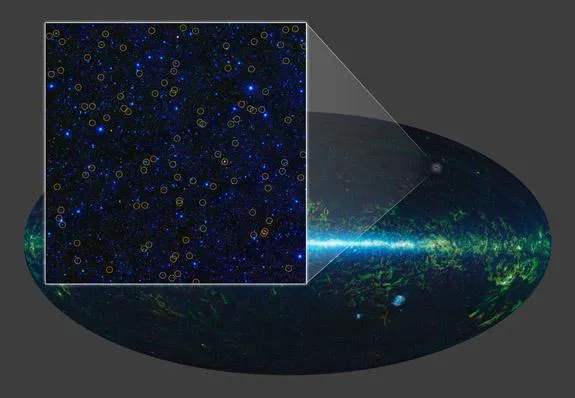Astronomers Find More Than 1,500,000 New Black Holes
Recent findings triple the number of known black holes in the universe
/https://tf-cmsv2-smithsonianmag-media.s3.amazonaws.com/filer/2012083012000608_30_2012_black-holes-11.jpg)
Tripling the number of known black holes in the Universe, astronomers announced the discovery of roughly 1,650,000 new black holes in a study posted online this week. They were working with observations from NASA’s WISE satellite, which aimed to map how the entire sky looks in infrared light, and though the WISE satellite’s mission ended last year, NASA says scientists working with the data it collected are still making a range of surprising discoveries.
Supermassive black holes that are busy gobbling up material such as stars and dust (as seen in this artist’s conception) are known as quasars. When a black hole feeds, the dusty ring surrounding a black hole heats up, providing the abundant infrared radiation that the WISE satellite can pick up on, according to a release about the findings issued by Berkeley:
“In one study, astronomers used WISE to identify about 2.5 million actively feeding supermassive black holes across the full sky, stretching back to distances more than 10 billion light-years away. About two-thirds of these objects never had been detected before because dust blocks their visible light. WISE easily sees these monsters because their powerful, accreting black holes warm the dust, causing it to glow in infrared light.”

Some of the newly discovered black holes, pulling from just one small patch of the sky, are highlighted by yellow circles. Black holes are known to exist at the centers of many galaxies, including our own Milky Way. Luckily, the universe is large enough that even with 2.5 million of these terrifying matter traps drifting about, neither Earth nor any of its inhabitants are likely to slip through one of its cracks.
More from Smithsonian.com:
Record-breaking Black Hole
A New Kind of Black Hole
Sixteen Years of Black Hole Watching Pays Off
/https://tf-cmsv2-smithsonianmag-media.s3.amazonaws.com/accounts/headshot/smartnews-colin-schultz-240.jpg)
/https://tf-cmsv2-smithsonianmag-media.s3.amazonaws.com/accounts/headshot/smartnews-colin-schultz-240.jpg)